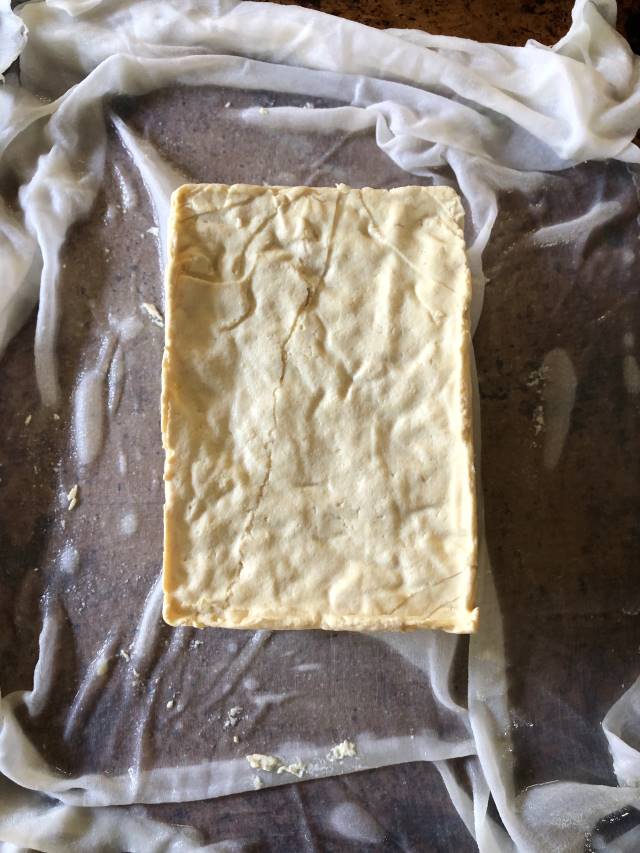
Of all the cooking projects that I do in my kitchen, making tofu from scratch is the most wondrous. I’ve been making tofu since around 2010 and wrote Asian Tofu, a book about making, buying, and cooking with tofu. It’s a marvel to start with soybeans and then end up with a luscious block of creamy, flavorful tofu.
The 2012 book contains detailed instructions and I also made an ebook with instructional videos dedicated to making different kinds of tofu. But sometimes, you just need extra help! Right now, more people are into project cooking, particularly DIY ones. I’ve fielded a number of tofu making questions from folks. I’ve also seen gorgeous tofu that people like food journalist Sam Fromartz crafted from the Asian Tofu cookbook.
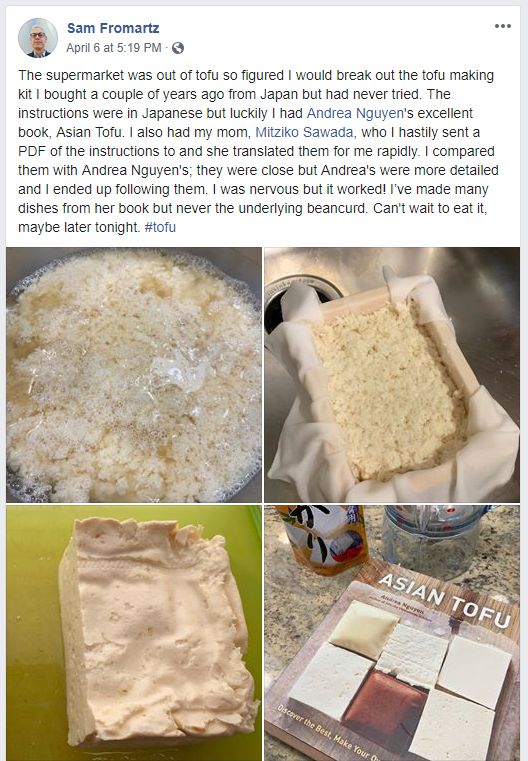
People have different learning styles and since I can’t do in person tofu making classes right now, I decided to make a video to teach you how. I spent days on this project since I’m new to video production and am a one-person shop. The result is a two-part recipe video on how to make tofu.
In this post, you’ll gain insights on how to make block tofu (the most common kind sold in a water-filled tub). First off though, you need to gather the ingredients and equipment that will help you succeed.
Tofu Ingredients: Soybeans and Coagulant Options
There are only 3 ingredients to making tofu – soybeans, coagulant and water. For the soybeans, choose a high protein, high fat bean that’s uniform in size. When I made my first batch of tofu in 2009, I went to the local hippie health food store and bought what I could find. I was able to make tofu though the curds were tiny. They weren’t the best beans and my technique was definitely beginner level.
Then I noodled around and during my field research in Asia and America, I settled on mail ordered Laura soybeans from Iowa. It’s a proprietary non-GMO breed that the Chambers family grows. The beans are consistently delicious and grown for human consumption, particularly for making tofu, soy milk and tempeh. It’s a handsome quality bean. You can order it on Amazon or through their website.
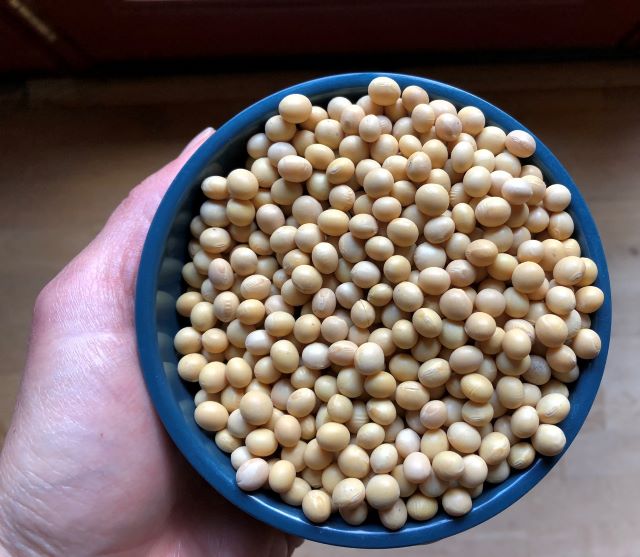
For detailed tips, check out this soybean sourcing guide I wrote. You’ll get parameters to help you find your own.
With regard to coagulant, I’m a fan of gypsum and nigari. Gypsum is easier to find, as you’ll read in my tofu coagulant buying guide, which outlines your options, including sourcing tips. Spoiler alert: I use gypsum in the recipe video posted here.
Tofu Making Equipment: Fabric and Tofu Mold
Along with the soybeans and coagulant, you need two pieces of fabric and a tofu mold to make tofu. One piece of fabric is for pressing out the soymilk. I use an 18-inch (½ meter) of unbleached muslin. Lightweight muslin is my kitchen workhorse fabric for straining stock, broth, and soy milk. Here’s information on why muslin is better than cheesecloth.
Muslin is sold at fabric shops but you may also use a nut milk bag like this one or this one, as suggested by one of my Asian Tofu recipe testers.
The other piece of fabric should come with your tofu mold when you buy it. It’s a sheer fabric used for lining the mold and holding the curds. If you have to source it, try a very lightweight fabric—lighter than the muslin you use to press out soy milk. But again, if you buy a tofu mold, the liner fabric typically comes with the mod.
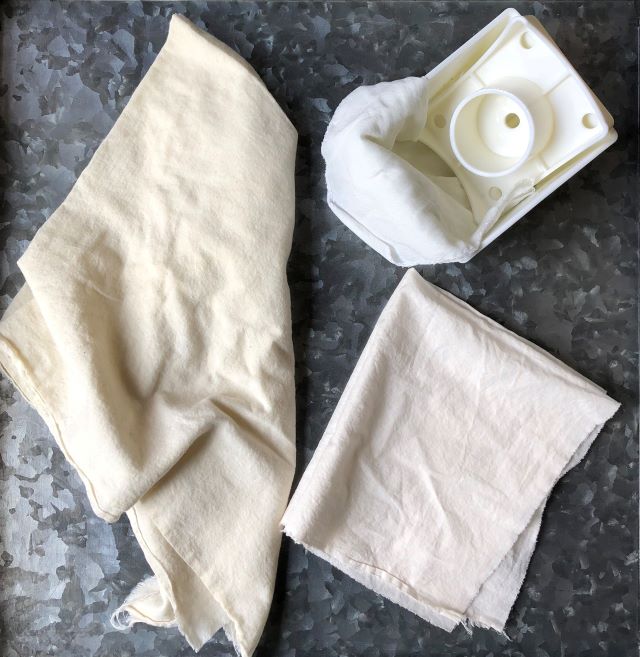
For the tofu mold, choose either plastic or cypress (wood). The plastic one is smaller than the wooden one and my block tofu recipe fits both. My wood mold is made from cedar and cost about $50 back in 2010. Cypress is fine as it expands and contracts well. I’ve never had mold grow on the wood mold because I let it dry thoroughly.
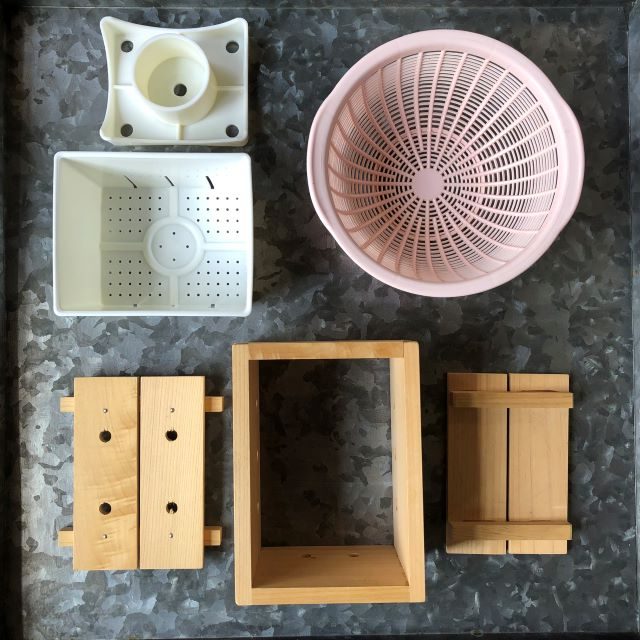
If you’re handy, you may make your own tofu mold. My wooden mold had the following interior dimensions: 3 inches deep, with an opening measuring 4 by 5 ¾ inches.
In a pinch, use a small strainer like the pink one below. Some people have fashioned an impromptu tofu mold from a repurposed milk carton; remember to poke holes for drainage. If you want to source your own fabric for
Homemade Tofu Recipe
There are many kinds of tofu you can make at home and the Asian Tofu book offers instructions to make them from scratch. This recipe makes fresh “block tofu” which is like what you commonly find in a sealed tub filled with water at the grocery store. (The stuff you get at the supermarket won’t be this fresh!)
My tofu video recipe is broken into 2 parts. The first is about making soy milk and the second part focuses on coagulating the milk into curds.
DIY Tofu Part 1: Make soy milk. Gather the following:
- 6 ounces dried soybeans
- 8 cups water (filtered or spring preferred)
Notes on soaking soybeans: Rinse and soak dried soybeans like you would other beans. I used to not change the water and even use the soaking water (I live in a drought-prone area so I try to minimize water waste) but recently have been changing the water partway through the soaking. I also drain, quickly rinse and use new water. If I remember, I'll use the soaking water to water my garden. Soaking and sprouting are suppose to help make soybeans more digestible (less gassy). I've eaten sprouted tofu and didn't find that it did much for my system. Experiment and see! It's just 6 ounces of beans at a time.
Now here’s the video on what to do with those two ingredients:
(If you want to know if you can make soy milk for tofu in a soy milk machine, check this post on Homemade Tofu Short Cuts.)
DIY Tofu Part 2: Turn Soy Milk into Tofu. Along with the freshly made soy milk, ready the following:
- About 1 ½ teaspoons packed refined nigari crystals, gypsum, or Epsom salts; or 2 teaspoons liquid nigari
- ½ cup (120 ml) water (filtered or spring preferred), for coagulating the soy milk
Here’s what to do in video format:
How to Manipulate Tofu Texture
How much weight you put on the filled mold and how long you keep the weight on determines the resulting texture. In the tofu making video, I use food cans. You can improvise with a cutting board plus a food can, or a bowl or jar filled with water. Here are my weight guidelines from the Asian Tofu cookbook:
- Medium texture: apply a 1-pound weight for 15 minutes
- Medium-firm texture: apply a 1.5- to 2-pound weight for 15 minutes
- Firm: apply a 3-pound weight for 20 minutes
Midway through, check that the weight is not lopsided so as to unevenly distribute its pressure. You can also remove the lid, unfold the fabric and poke at the tofu. In the mold the tofu will feel soft and squiggly. However, it will firm up once fully cooled.
You can always keep the weight on longer to yield firmer tofu, but the reverse is not true. If you like, open the cloth and press the surface with your finger to gauge texture. Don’t be afraid to experiment, as that’s what tofu makers do. When you’re satisfied, remove the weight.
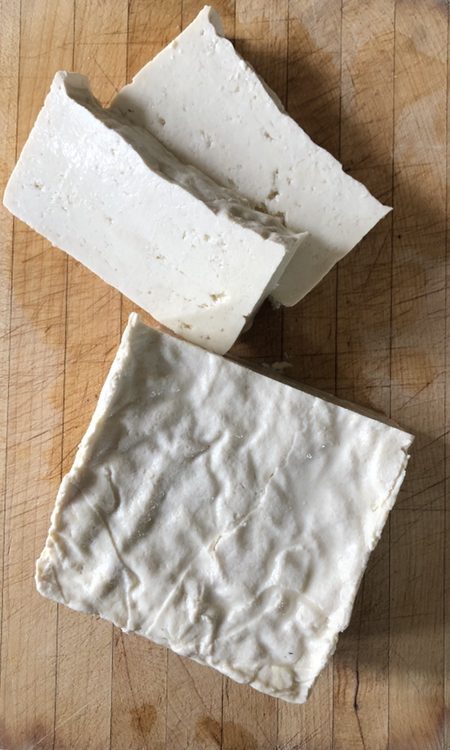
Storing Homemade Tofu
You can your homemade tofu as soon as it has completely cooled, though many people say tofu needs 2 hours to rest to develop its full umami. If you are not eating the fresh tofu soon, refrigerate it in an airtight container, with water to cover, for up to 1 week. Change the water every other day.
I like using a tofu storage box with a caddy for lifting out the tofu. I found mine at a Japanese market but there's also a handsome tofu box sold online too.
Enjoying Fresh Tofu
Like fresh bread and cheese, I eat homemade tofu simply to allow it to best express itself. That means, most times, I served the tofu chilled and cut into cubes, seasoned with good soy sauce (see this mega buying guide or make a Japanese umami-laden soy concentrate), chile oil, and or Chingkiang vinegar. I may also garnish it with some or all of the following: sliced green onion, herbs (shiso, tia to, cilantro), nori strips, and grated ginger.
Treat homemade tofu like fresh mozzarella and serve it with olive oil, coarse salt, tomato and basil. It's great with avocado, salt and olive oil.
You can certainly use your tofu in cooked preparations like mapo tofu too!
If you’re a tofu geek and would like to explore the incredible world of tofu, check out my book.
Here’s a preview of Asian Tofu, including a gallery of recipe photos in the book. If you want to focus on just making DIY tofu, purchase Making Soy Milk and Tofu at Home; here are details on the enhanced eBook, which contains video instructions for preparing different kinds of tofu at home.
Feel free to ask tofu questions and I'll answer them as best as I can!













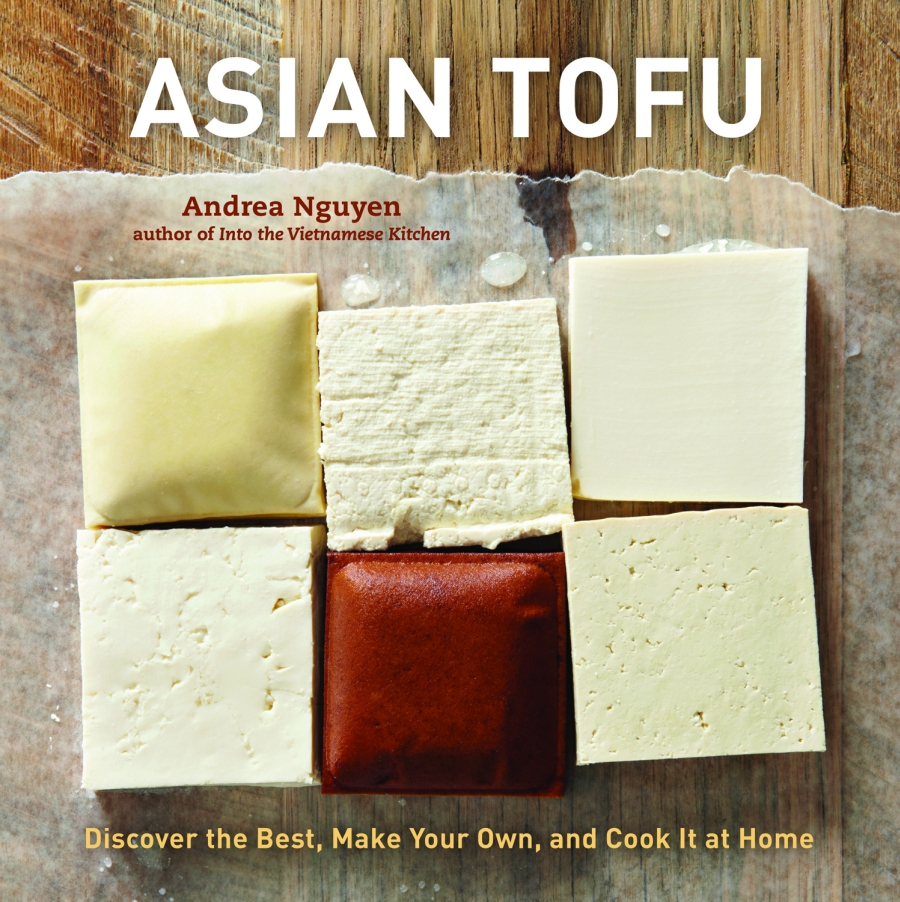
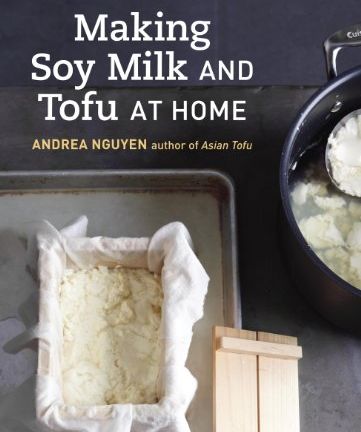




Mary Ann Lynch says
Made my first homemade tofu using your instructions. It's in the press now, so I don't yet know the result. I am hopeful.
But I have questions. While making the light soy milk, the milk never foamed up as you show in your video. I cooked it for a much longer time than you suggest it will take (easily 20 minutes if not longer) and brought it to a boil, but still no foam. I eventually decided to proceed with making the tofu.
The only stage at which the soy milk foamed was early shortly after adding it to pot of preheated water. The temp was around 150 to 160 degrees at that point. As I continued to heat and stir, the foaming receded until there was just a minor amount of foam.
So, is it a problem that I didn't get the foam. Should I have continued to boil it for longer?
Another question, is how long in total must the soy milk cook to be considered edible and does it need to be at a particular temperature during the cooking?
Any thoughts will be appreciated.
Thanks
Andrea Nguyen says
You're lucky to not have foam. The pot may not have heated up enough, that's all. But your long cooking time must have been fine. I'm typically simmering the soy milk but frankly, I don't take the temperature. I'm sure by now, you've had the tofu and are feeling okay with it? That's what's most important. Thanks for using the recipe!
Stan & Diane Yamane says
Great videos. My husand and I will make tofu!
Please may I make a request? I am hearing impaired and due to that, the background music is same volume as your voice. You are soft spoken and some of the verbal direction is lost in the music. Music in scene transitions is fine, with none while you ae speaking.
Close captions would also be helpful
Thank you so much for this instruction, Diane
Andrea Nguyen says
You're welcome, Diane. I do these videos all on my own so they're a work in process. I'm a writer more than a video production company. Thanks for understanding. You may get a copy of Asian Tofu or the ebook on Making Soy Milk and Tofu. Then you'll have detailed written instructions. The combo will help you truly master this.
Kathryn Fourie says
Andrea! Your Tutorials 1 & 2 have saved me - thanks so much. I was making batch after batch of teeny tiny curds using lemon juice and just chucking it all into the milk at once and stirring it. On the second go using the Gypsum (I am lucky my husband brews beer and had a bag on hand) - I almost screamed in delight to get the omelette-like cumulus clouds! Not only is my tofu now tasting and feeling like real tofu, I am getting about three times more actual curds. I can't thank you enough. Just wish I could find a tofu press in South Africa - but trying to get a carpenter friend to make me one 😉 Will definitely be buying your book soon.
Andrea Nguyen says
WOOOOOOHOOOOO! People have asked about lemon juice and fermented whey for coagulation but using them is iffy for homecooks. But your husband brews beer! So happy for you and delighted that I was able to help.
Thanks in advance for supporting the Asian Tofu book, too!
Sy says
Regardless of how long I press my tofu it never gets extra firm like store bought. Any secrets to getting my homemade tofu extra firm?
Andrea Nguyen says
More weight and time. That said, tender tofu has lovely flavor and texture. It will absorb seasonings much better.